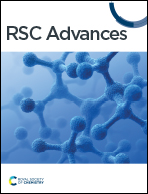In situ polymerization of a melamine-based microsphere into 3D nickel foam for supercapacitors†
Abstract
An in situ synthesis approach is used to directly grow a microsphere of melamine-glutaraldehyde (MAGA) polymer over three-dimensional (3D) nickel foam (NF). The materials are used to produce nitrogen-doped carbon (NC) with and without NF. These precursors undergo carbonization at various temperatures, namely 400 °C, 500 °C, and 700 °C. The electrochemical properties of the materials would be significantly improved by directly growing MAGA polymer on the surface of NF. The electrochemical performance of NC/NF-400 was excellent, with a capacitance of 297 F g−1 achieved at a current density of 1 A g−1. The in situ growing approach does not necessitate the use of additional chemical agents, such as binders or conductive compounds when preparing the electrode. In addition, the material exhibits only 10% reduction in capacitance after undergoing 5000 cycles, indicating excellent cycling performance. The outstanding electrochemical performance achieved by using the in situ method of MAGA microsphere polymer on NF may be attributed to the rapid transit of ions to the electrode surfaces, facilitating effortless redox reactions.



 Please wait while we load your content...
Please wait while we load your content...